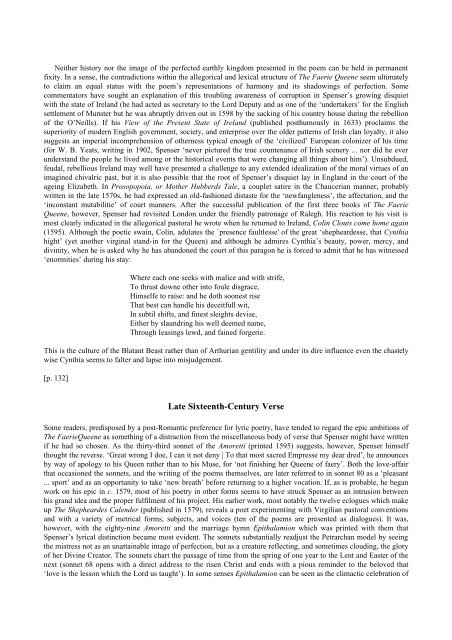THE SHORT OXFORD HISTORY OF ENGLISH LITERATURE
THE SHORT OXFORD HISTORY OF ENGLISH LITERATURE
THE SHORT OXFORD HISTORY OF ENGLISH LITERATURE
Create successful ePaper yourself
Turn your PDF publications into a flip-book with our unique Google optimized e-Paper software.
Neither history nor the image of the perfected earthly kingdom presented in the poem can be held in permanent<br />
fixity. In a sense, the contradictions within the allegorical and lexical structure of The Faerie Queene seem ultimately<br />
to claim an equal status with the poem’s representations of harmony and its shadowings of perfection. Some<br />
commentators have sought an explanation of this troubling awareness of corruption in Spenser’s growing disquiet<br />
with the state of Ireland (he had acted as secretary to the Lord Deputy and as one of the ‘undertakers’ for the English<br />
settlement of Munster but he was abruptly driven out in 1598 by the sacking of his country house during the rebellion<br />
of the O’Neills). If his View of the Present State of Ireland (published posthumously in 1633) proclaims the<br />
superiority of modern English government, society, and enterprise over the older patterns of Irish clan loyalty, it also<br />
suggests an imperial incomprehension of otherness typical enough of the ‘civilized’ European colonizer of his time<br />
(for W. B. Yeats, writing in 1902, Spenser ‘never pictured the true countenance of Irish scenery ... nor did he ever<br />
understand the people he lived among or the historical events that were changing all things about him’). Unsubdued,<br />
feudal, rebellious Ireland may well have presented a challenge to any extended idealization of the moral virtues of an<br />
imagined chivalric past, but it is also possible that the root of Spenser’s disquiet lay in England in the court of the<br />
ageing Elizabeth. In Prosopopoia, or Mother Hubberds Tale, a couplet satire in the Chaucerian manner, probably<br />
written in the late 1570s, he had expressed an old-fashioned distaste for the ‘newfangleness’, the affectation, and the<br />
‘inconstant mutabilitie’ of court manners. After the successful publication of the first three books of The Faerie<br />
Queene, however, Spenser had revisited London under the friendly patronage of Ralegh. His reaction to his visit is<br />
most clearly indicated in the allegorical pastoral he wrote when he returned to Ireland, Colin Clouts come home again<br />
(1595). Although the poetic swain, Colin, adulates the `presence faultlesse' of the great ‘shepheardesse, that Cynthia<br />
hight’ (yet another virginal stand-in for the Queen) and although he admires Cynthia’s beauty, power, mercy, and<br />
divinity, when he is asked why he has abandoned the court of this paragon he is forced to admit that he has witnessed<br />
‘enormities’ during his stay:<br />
Where each one seeks with malice and with strife,<br />
To thrust downe other into foule disgrace,<br />
Himselfe to raise: and he doth soonest rise<br />
That best can handle his deceitfull wit,<br />
In subtil shifts, and finest sleights devise,<br />
Either by slaundring his well deemed name,<br />
Through Ieasings lewd, and fained forgerie.<br />
This is the culture of the Blatant Beast rather than of Arthurian gentility and under its dire influence even the chastely<br />
wise Cynthia seems to falter and lapse into misjudgement.<br />
[p. 132]<br />
Late Sixteenth-Century Verse<br />
Some readers, predisposed by a post-Romantic preference for lyric poetry, have tended to regard the epic ambitions of<br />
The FaerieQueene as something of a distraction from the miscellaneous body of verse that Spenser might have written<br />
if he had so chosen. As the thirty-third sonnet of the Amoretti (printed 1595) suggests, however, Spenser himself<br />
thought the reverse. ‘Great wrong I doe, I can it not deny | To that most sacred Empresse my dear dred’, he announces<br />
by way of apology to his Queen rather than to his Muse, for ‘not finishing her Queene of faery’. Both the love-affair<br />
that occasioned the sonnets, and the writing of the poems themselves, are later referred to in sonnet 80 as a ‘pleasant<br />
... sport’ and as an opportunity to take ‘new breath’ before returning to a higher vocation. If, as is probable, he began<br />
work on his epic in c. 1579, most of his poetry in other forms seems to have struck Spenser as an intrusion between<br />
his grand idea and the proper fulfilment of his project. His earlier work, most notably the twelve eclogues which make<br />
up The Shepheardes Calender (published in 1579), reveals a poet experimenting with Virgilian pastoral conventions<br />
and with a variety of metrical forms, subjects, and voices (ten of the poems are presented as dialogues). It was,<br />
however, with the eighty-nine Amoretti and the marriage hymn Epithalamion which was printed with them that<br />
Spenser’s lyrical distinction became most evident. The sonnets substantially readjust the Petrarchan model by seeing<br />
the mistress not as an unattainable image of perfection, but as a creature reflecting, and sometimes clouding, the glory<br />
of her Divine Creator. The sonnets chart the passage of time from the spring of one year to the Lent and Easter of the<br />
next (sonnet 68 opens with a direct address to the risen Christ and ends with a pious reminder to the beloved that<br />
‘love is the lesson which the Lord us taught’). In some senses Epithalamion can be seen as the climactic celebration of









